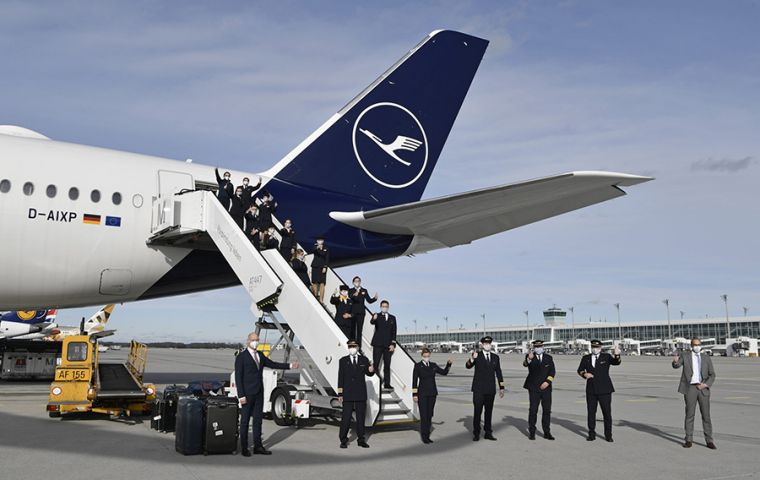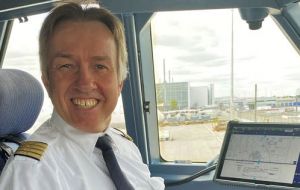MercoPress. South Atlantic News Agency
Hamburg/Falklands/Munich: details from Lufthansa's longest nonstop flights
 Lufthansa Airbus A350-900 arrived at MPC early Monday February first and on Wednesday was back in the air arriving in Munich on Thursday 4 February
Lufthansa Airbus A350-900 arrived at MPC early Monday February first and on Wednesday was back in the air arriving in Munich on Thursday 4 February  Falklands' weekly Penguin News obtained a firsthand description from Project Manager Captain Thomas Jahn and Pilot Rolf Uzat in their outbound trip. (Pic LH)
Falklands' weekly Penguin News obtained a firsthand description from Project Manager Captain Thomas Jahn and Pilot Rolf Uzat in their outbound trip. (Pic LH) An airline preparing to launch its longest-ever flight – a fifteen-hour non-stop flight from Hamburg Germany to the Falkland Islands in an A350 – is as tricky a project as one might expect.
The Lufthansa Airbus A350-900 aircraft arrived at Mount Pleasant early Monday February first and on Wednesday was back in the air arriving in Munich on Thursday 4 February. At 14 hours, the flight clocked in at around an hour and a half shorter than the outbound journey on Monday.
Falklands' weekly Penguin News obtained a firsthand description from Project Manager Captain Thomas Jahn and Pilot Rolf Uzat in their outbound trip.
The aircraft carried 92 passengers on the charter flight half of which were scientists and the other half the ship’s crew for the upcoming expedition with the RV Polarstern research vessel. Once in the Falklands passengers were moved to RV Polarstern by Agents Stanley Services Ltd.
Captain Jahn told Penguin News: “The entire project really gained momentum in October 2020, when we were awarded the contract.
“Apart from the operational questions like airport suitability, fuelling, catering, handling, route proving I had to evaluate the difficulties for the crew being confined to their room for one week and to the quarantine location for another week.
“The main concern was social isolation and we had to fill their day with activities. At 9:30 in the morning a conference call was scheduled to find out whether or not everybody was OK, at 11:00 am they had their conference call sports session. Believe it or not, some of them were able to do a half-marathon inside. At 2:30 pm I was patched in (fleet management) as well as the cabin crew management to inform them about any changes and to answer questions, Finally, at 4:30 pm they had their cultural conference channel to talk about the history of the Falkland Islands, Magellan’s voyages...
How did Cockpit Crew prepare for this flight? Penguin News asked Captain Uzat:
“Well, as for every flight. There is a special routine that every pilot tries to establish over his career.
“Me, personally, I start with an Atlas map to localize the destination and its surroundings. The internet can be very helpful to. “Then Lufthansa provides us with the up to date IFR Charts to prepare the Route. Many countries with different regulations need to be met. But, as Felix (Second Cpt) and I have flown at least 3/4 of our direction south already many times, we were familiar with most of the Route.
Simulator training
“The last training took place in our Airbus 350-900 Simulator in Munich. Within Lufthansa Company Regulations, Mount Pleasant is a Category C airport, meaning, Crews need to have training in the simulator to get familiar with the weather, the surrounding terrain and ATC procedures. “This was all done in advance as per regulation.”
Project Manager Captain Jahn added: “A simulator program was designed to practice approaches at Mount Pleasant, Ushuaia, Punta Arenas and Rio Gallegos.
The latter being important in case of a diversion from Mount Pleasant due to weather, closures.
“Since a strong breeze is very common at the Falklands, crosswind landing technique was one of the highlights of the simulator training.
“In addition, we selected experienced pilots for this route and our selection obviously was a very good one.
“There will be another flight down there and we already have a good crew for that one as well.”
“How about the load on this flight and what comes with it?” That’s where the Load Control Department and Mission Support Group of Lufthansa come into play, explained Cpt Uzat.
“Our Airbus 350-900 almost received a full load of fuel for that flight. That is not normal, as the regular route structure has no necessity to do that. Do to the efficiency of these Rolls Royce Engines, the burn rate of the aircraft is exceptional. With an average of 5400kg/h, we even had some spare room for extra fuel.
“On this flight, the crew decided for 106t of kerosene. This would have let us circle the Falklands for an extra hour, if needed due to strong winds. After this additional hour we would have needed to divert to our legal alternate aerodrome.
“The big amount of fuel and the less passengers made it necessary to put business class passengers into economy class, so behind the centre of gravity position, to keep the aircraft balanced for the first 3 hours. On command of the captain, the cabin crew reseated the passengers.
Landed safe
“Thanks to the wind, we did not use this extra safety fuel. We landed safe with the remaining fuel of 15.6t.”
Cpt Thomas Jahn added: “As Rolf already mentioned, aircraft are not designed to fly with less than half of the passenger capacity but full tanks thus reseating was required during the flight. The passengers were allowed to bring 40kg per person on board and we also had a little bit of cargo amount which spare parts for the crane on the vessel RV Polarstern.
”106 tons of fuel sounds like a lot but other planes like the Airbus 340-600 would have catered 150 tons, the Boeing 747-800 at least 170 tons. The A350-900 is a very fuel efficient plane.”
The return flight LH2575, carried the RV Polarstern crew, which had set out from Bremerhaven on December 20 to resupply the Neumayer Station III in Antarctica.




Top Comments
Disclaimer & comment rules-

-

-

Read all commentsI wonder how they allocated the Business Class seats among the passengers?
Feb 06th, 2021 - 10:06 am 0Mr. Woodhead...(fitting surname...)
Feb 08th, 2021 - 11:56 am 0With a seat configuration of C36 - W21 - Y262..., i doubt that all 92 passengers on that Airbus got a Business Class seat...
Capisce...?
Think once the fuel was burned they all got one:)
Feb 07th, 2021 - 09:52 pm -2Commenting for this story is now closed.
If you have a Facebook account, become a fan and comment on our Facebook Page!